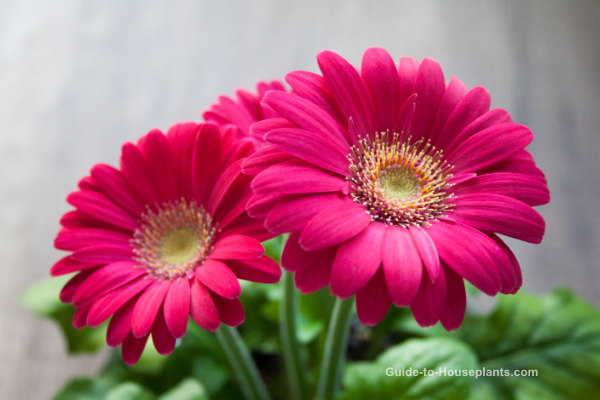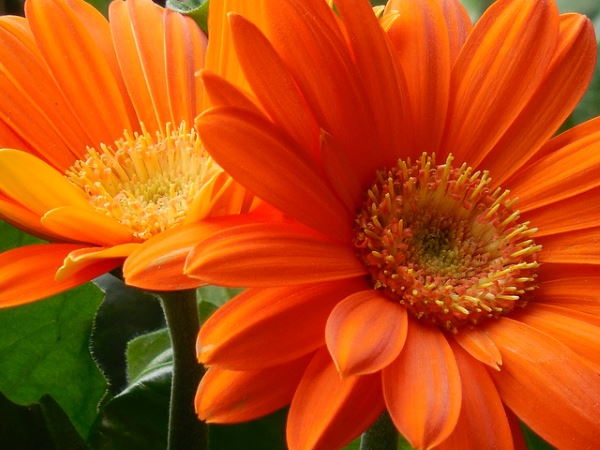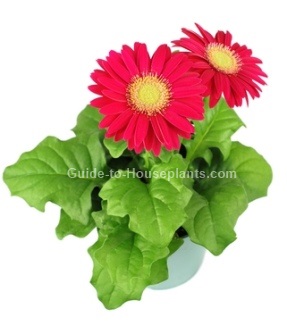Gerbera Daisy Care
Gerbera daisy care is so easy, it's no wonder these eye-catching flowers have become must-have houseplants. You'll find lots of colorful gerbera daisy plants popping up in florist's shops in spring and summer.
If you don't already know Gerbera jamesonii, you'll want to get acquainted. These sun-loving beauties have a lot to offer for your indoor garden.

Get to Know Gerbera Daisies
Big, velvety gerbera flowers are showy and long-lasting. They are held on thick, leafless stems above large, deeply veined leaves. The leaves are about 6 in (15 cm) long and are soft and furry on the undersides.
Native to South Africa, Gerbera jamesonii is also commonly known as Barberton daisy. How big does it get? They may reach a height up to 1-1/2 ft (45 cm). Dwarf varieties are 6-12 in (15-30) tall.
You'll find gerberas for sale in spring and early summer. Gerbera daisy colors range from soft pink, white and pale yellow to bright shades of pink, orange, purple and red. Newer hybrids are compact and produce up to 6 blooms at a time, making them ideal for growing indoors.
New plant? When you bring home a fresh pot of gerbera daisies, remove the decorative wrapping on the pot as soon as possible. Excess water will collect in the foil or plastic sleeve rather than drain, waterlogging the roots. See "water" tips below. Want to cover up a plain nursery pot? Slip it into a cachepot -- a decorative container without drainage holes. It's a good idea to put small rocks in the bottom of cachepots to hold the inner pot above the drainage water.
Breathe easier. They're not only beautiful, gerber daisies are good for you, too. Gerberas are among the best plants for improving indoor air quality. They have one of the top removal rates of toxins such as formaldehyde and benzene from tainted indoor air.
 Photo credit: Rebecca Matthews
Photo credit: Rebecca MatthewsGerbera Daisy Care: Problems, Solutions and Answers
Give gerbera plant some air. Allowing good air circulation around the plant will help to prevent leaf spot. This fungus will show up on the leaves as brown spots surrounded by light-colored borders. Isolate the plant and cut off any affected leaves. Treat with a fungicide made for leaf spot, if necessary.
Check for bugs. Check your house plants regularly for aphids. They tend to hang out on flower buds and stems. If you find an infestation, treat your plant right away because these little pests can harm your plants. Wet, peaty potting mixes sometimes attract fungus gnats; they look like tiny, black flies that hop or crawl on the soil.
Get more blooms. Once a flower fades, cut off the flower stem at the base of the plant. Called deadheading, removing spent flowers will encourage gerberas to keep blooming.
Don't overwater. Is your gerbera daisy wilted? If you're watering regularly and the whole plant collapses anyway, it may have root rot. Ease the plant out of the container and take a peek at its roots. Are they soft, mushy and brown? If so, the plant has root rot. Toss it out -- it's too far gone.
Are gerbera daisies poisonous? Wondering whether Gerbera jamesonii is safe for cats and dogs? Don't worry -- it's non-toxic, according to the ASPCA.

Gerbera Daisy Care Tips
Light: Bright light to full sun. Put your gerbera daisy plant on a bright windowsill, where it will get some direct sunlight. Growing gerbera daisies on your patio is another option, as long as the temperature doesn't rise above 75°F/24°C.
Water: Drench and dry. Water thoroughly. With gerbera daisy care should be taken not to allow any dry pockets around the roots, which can cause the plant to wilt. Water until you see water coming out the drainage hole and discard any water left in the saucer. Don't water again until the top 1 inch (2.5 cm) of soil is dry.
Humidity: Average room (around 40% relative humidity) or higher. If your home is dry, use a cool-mist room humidifier near your plant.
Temperature: Cool to average 55-75°F/13-24°C
Soil: Peat moss-based potting mix with added perlite and/or vermiculite for fast drainage. African violet potting mix is ideal.
Fertilizer: Feed every 2 weeks while in bloom with a balanced water-soluble fertilizer.
Propagation: Division or seeds


